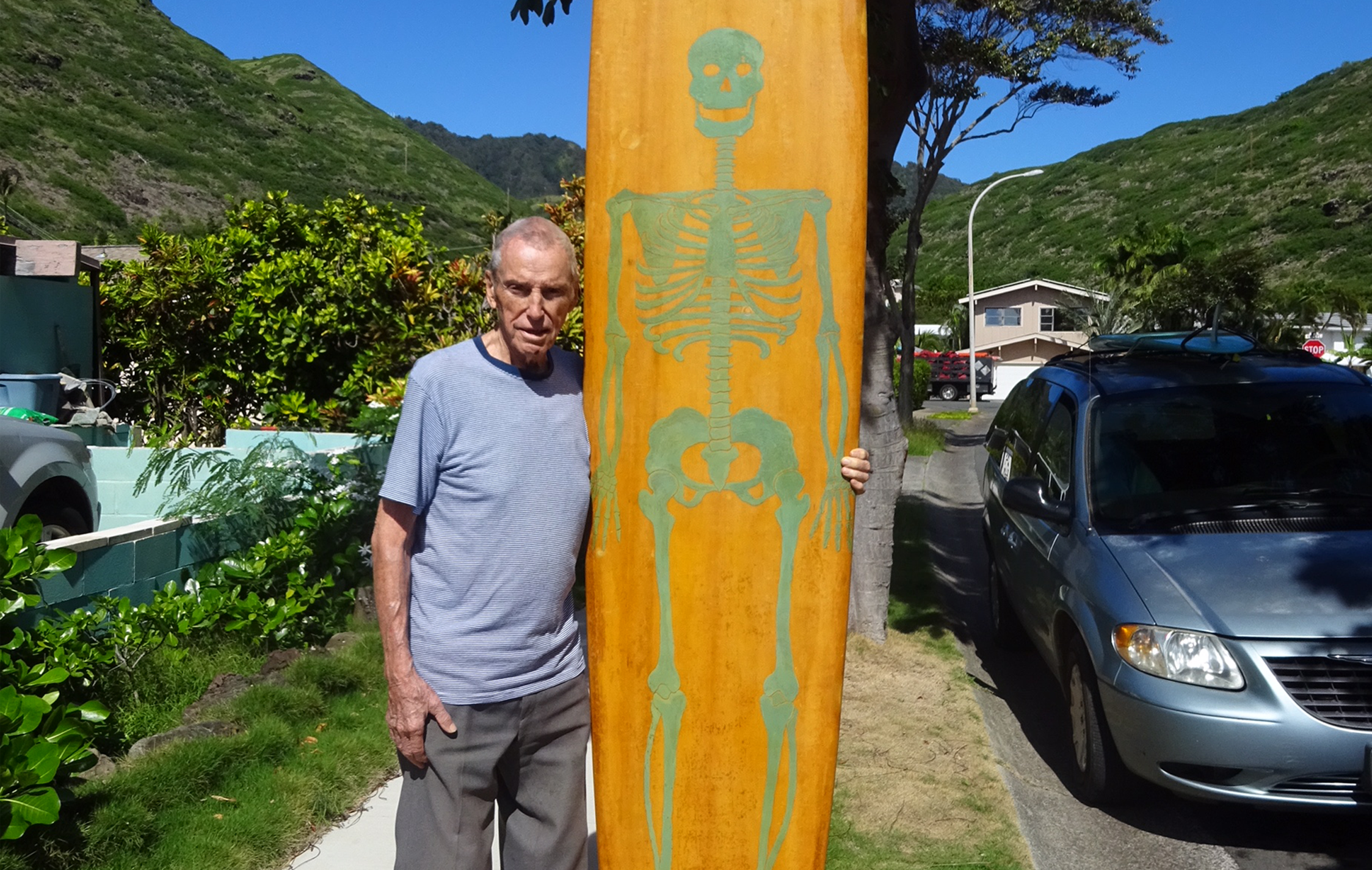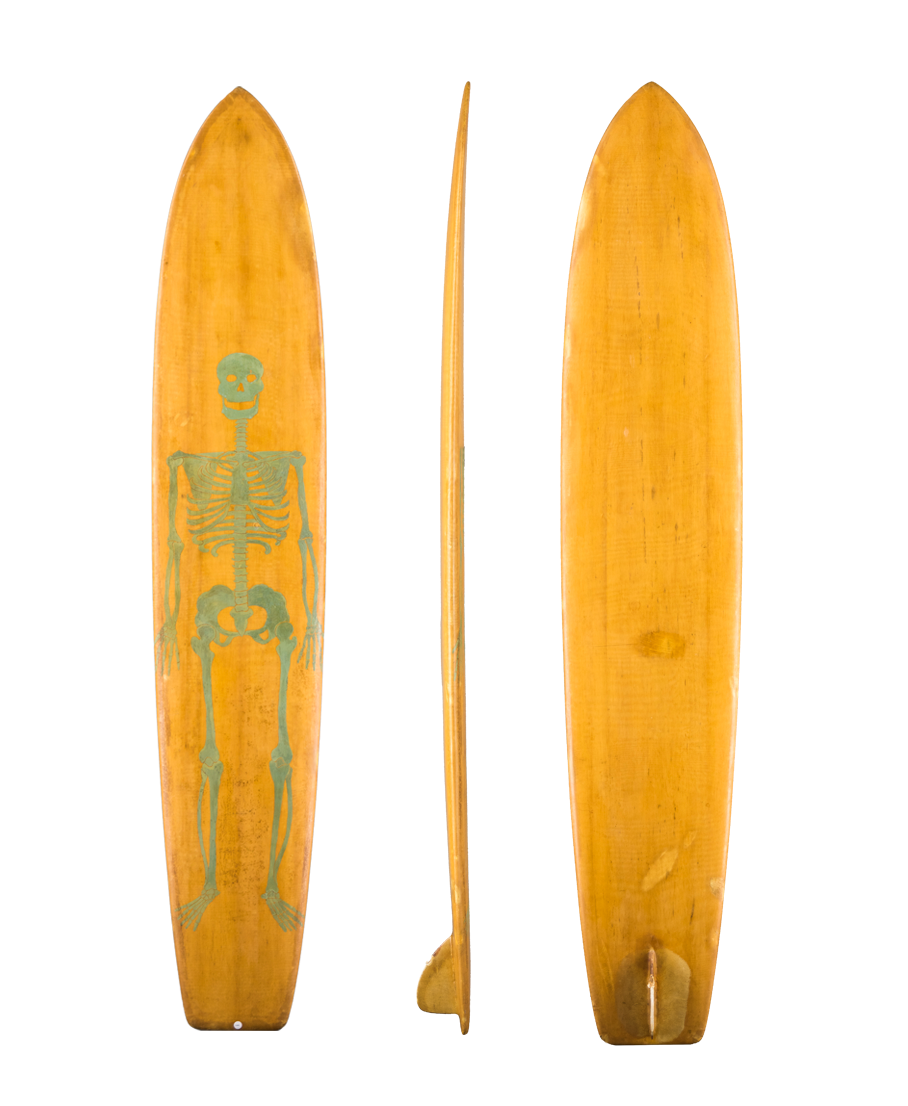Founder’s Corner: Joe Quigg’s “Skeleton” Malibu Chip
Joe Quigg posing with the “Skeleton” Malibu Chip.
Shaped by legendary craftsman Joe Quigg in the late 1940s, the “Skeleton” board, built with the design characteristics of a classic Malibu Chip, was originally built for a young woman in medical school. Her mother, an art teacher at Punahou School on Oahu, painted the skeleton on the board for her. It’s made with balsa wood, features at glassed-in fin and weighs in at 30 pounds.
Joe Quigg’s “Skeleton” Malibu Chip, S.696, in the SHACC collection.
View S.696 in the SHACC eMuseum. →
”[Joe Quigg] clarified that when he made the board for Jane Wyllie, it was just clear. It turns out Jane’s mom is the one who painted on the skeleton, since her daughter was a medical student. He said it was either 1948 or 1949, he couldn’t remember for sure what year,” recalled surfboard collector Randy Rarick. “The board has sun cured 2 oz. cloth and he said they went to bigger fins after using this template as they needed more holding power. Said that it was a really good example of the ‘girl’s boards’ that he was making at the time and that once the men started to try them, everything changed.”
An eye-catching surfboard that’s garnered a lot of attention over the years, the board has appeared in the books “Finding Paradise” and “Surfs Up: Collecting the Longboard Era.”
Born in Los Angeles in 1925, Quigg ranks among one of the most important surfers and surfboard builders of the modern era.
Growing up in Santa Monica, he first took to the water when he was only four years old, building himself a crude billboard. By the time he was 13 years old he had made his first redwood board, complete with a preliminary attempt at creating nose and tail rocker. Years later, Quigg would say that his early experiments with rocker was his greatest contribution to surfboard design and performance.
Highly influenced by pioneering watermen such as Pete Peterson, Lorrin Harrison and Gard Chapin, Quigg fell right into the L.A. surf life of the 1930s.
“When I was 6 and 7 years old, I watched Peterson ride at the Santa Monica pier. He lifeguarded there and jumped in from the pier. He was just magic to me—so easy, so talented, and such a great athlete,” recalled Quigg in a 1998 Surfer’s Journal interview with Steve Pezman. “Lorrin Harrison would come up to see Peterson. He was a little wilder in his mannerisms and his personality—the way he surfed. He’d wave and jump and tear all around. When he was young, he was quite a wild guy. Peterson was a better surfer, but he didn’t try to be wild like that. I thought Gard Chapin was the living end. When I started going to San Onofre, Hermosa, and Palos Verdes, I’d see him there and he would come up to Malibu and just run circles around everyone.”
During World War II he spent four years in the Navy, eventually returning to Santa Monica in 1947. It’s during this time after the war that Quigg began focusing more of his time around Malibu and designing boards with the likes of Bob Simmons and Matt Kivlin.
In ’47, Quigg crafted an experimental balsa-redwood hybrid for Darrylin Zanuck, daughter of Hollywood mogul Darryl Zanuck. Thinner and lighter than any other boards of the era, the 25-pound “Darrylin” model became the precursor to the Malibu chip. It’s during this time that Quigg and Simmons also began to develop the first polyurethane foam-core boards, an all-fiberglass fin, and a narrow-base raked-back fin. He also began to develop the first pintails, designed to handle better in bigger surf.
In 1950, Quigg opened a production-retail surfboard shop in Santa Monica in 1950 followed by a shop in Honolulu in 1953, after he relocating to Oahu. He moved to Newport Beach from 1959 to 1969 before returning to Hawaii.
Settled in the Islands, Quigg continued to design and built aquatic craft of all types, including boats, canoes. He eventually retired from full-time production in 1987.
Joe Quigg peacefully passed away at home in Hawaii on June 20, 2021. He was 96 years old.


